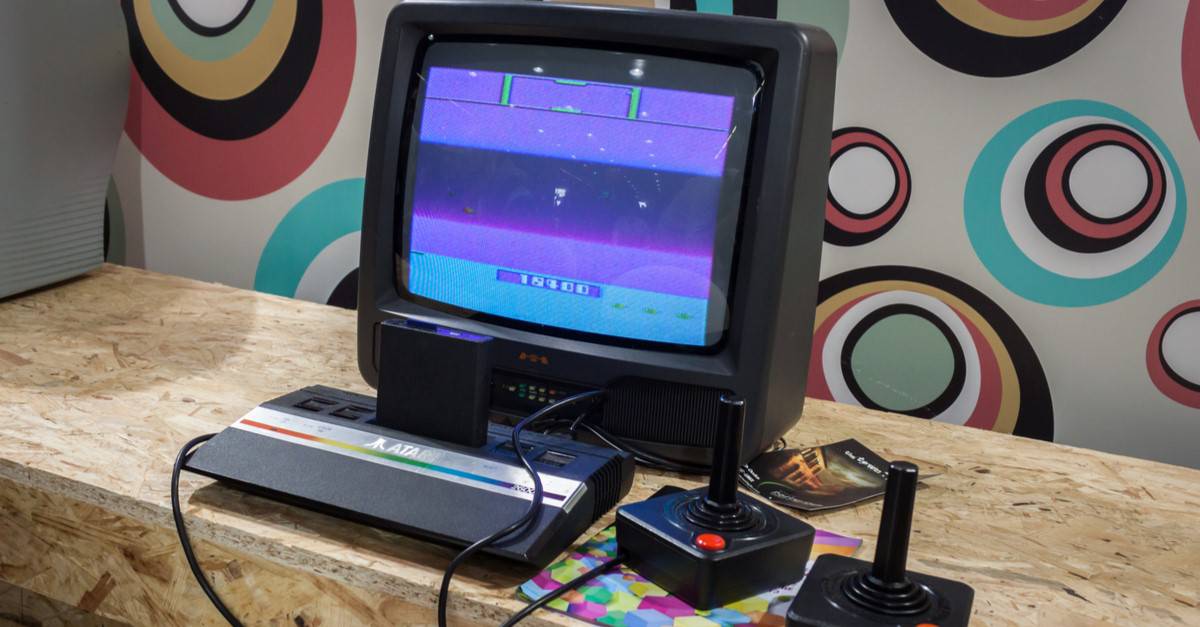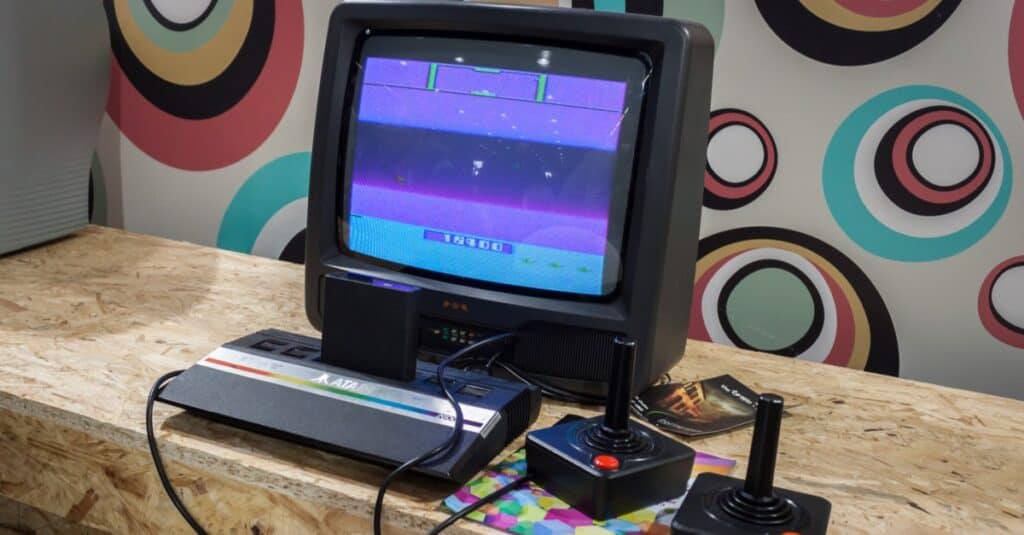
©Tinxi/Shutterstock.com
The history of video games is longer than most people think. Atari, Inc. was a pioneer in arcade games, home video game consoles, and home computers in its early years.
Atari is largely responsible for the existence of arcade gaming cabinets and the proliferation of love for video gaming by the average person.
Quick Facts
- Year Founded
- 1972
- Founders
- Nolan Bushnell and Ted Dabney
- Industry
- Electronic Entertainment
- Headquarter
- California
- Key People
- Nolan Bushnell, Ted Dabney, Allan Alcorn
- Notable Products
- Atari 2600, Atari 400 and 800, Atari ST, Atari Lynx, Atari Jaguar
- Website
- https://www.atari.com/
The History of Atari: What to Know
Atari was founded in 1972 by Nolan Bushnell and Ted Dabney. The two-man team had started under the name Syzygy Co in 1971. Strange enough, the name Syzygy Co was taken in California. The duo decided to change the name to Atari, Inc. Bushnell was a fan of the ancient Chinese board game Go. In Go, there’s the word ‘Atari’ which means “I’m about to win”. It’s similar to saying “checkmate” in chess.
Dabney had invented an early technology for movement on a screen called Spot Motion Circuit. With his addition, a dot could move up, down, left, and right on the screen without the addition of an expensive computing unit. This was game-changing technology that allowed for the creation of the video game arcade cabinets. The first game ever commercially sold was Computer Space, but it was Atari’s first that gained immense traction.
In 1972, a new hire at Atari named Allan Alcorn was assigned a project as a test. Alcorn was unfamiliar with video games until Bushnell introduced him to Computer Space. This made the result of his performance test even more impressive. After months of work refining his first project, Alcorn presented Atari with Pong. The game was not intended to have been made for commercial release, but the company enjoyed Pong so much that it became their flagship title.
Pong was a major hit. Bars, restaurants, amusement arcades, and random other places around the world wanted to get a hold of it. Unfortunately, Atari wasn’t able to make their production match the demand. The company did not only just make the machines.
They also sent representatives to manage the coin collection. Part of the arrangement for hosting a Pong cabinet was that the establishment received 50% of the earnings. Atari didn’t have the manpower to staff a collection team too large. In the end, it is estimated that only around 12,000 Pong cabinets were ever made.
Atari didn’t have the patent for Pong until the game had been released. This allowed others to copy the game and offer imitations as competition. Magnavox, a competitor in the home computing video game industry, accused Atari of stealing their game Tennis Table. Bushnell and Dabney decided to settle the case outside of court.
They didn’t want to spend the time and money battling for the legal rights of a game that was being imitated across the country. Instead, they began to focus on creating new games. It was during this game library expansion that Atari had employed both Steve Jobs and Steve Wozniak. The team had created Breakout to join Atari’s other new games Space Race, Tank, and Gotcha. It was only a few years later that Steve Jobs and Steve Wozniak would leave to create Apple Computer.
By 1974, Bushnell had begun overreaching. The company was spread too thin with international expansion. They also placed too much faith in a complicated and expensive to maintain arcade cabinet game named Gran Trak 10. However, Atari was able to stay afloat with the hit success of their game Tank and by rejoining with their sister company, Kee Games.
Then in 1976, Atari went Corporate. Warner Communications purchased Atari from Bushnell for $28 million. It was during the corporate reign that Atari created the VCS and the Atari 2600.
The Founding of Atari: How It Happened
In 1971, Ted Dabney and Nolan Bushnell released the first-ever coin-operated arcade machine. The game was called Computer Space. The project had been commissioned by Nutting Associates and was considered to be a failure. The game still sold 1500 units and allowed Bushnell and Dabney to set out on their new adventure.
They founded the company later that year under the name of Syzygy Co. They changed the name to Atari, Inc after discovering Syzygy Co was already taken, luckily. They hired Allan Alcorn, an engineer who had worked with Bushnell and Dabney at Apex. After Alcorn finished his first project, Atari launched production and management of Pong arcade cabinets across the country and overseas.
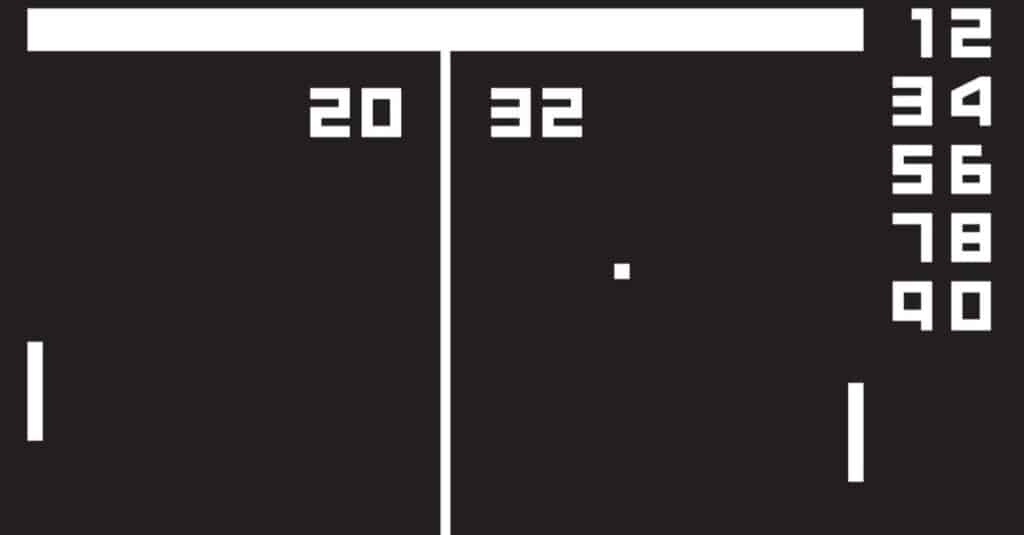
©WHISKHEELS/Shutterstock.com
Atari: Through the Decades
1970s
The 70s were the formative years for Atari. The founding duo of Dabney and Bushnell had already begun their first game creation in 1969 for Nutting Associates. By 1971, they completed the project and cemented their idea for a path forward as arcade game makers. They set about hiring their team starting with their first programmer, Allan Alcorn. After the creation of Pong, Atari, Inc had found a solid start in the gaming industry.
After Pong’s success, Dabney sold his stock shares of Atari to Bushnell in 1973. They had created their library of games, made a name for themselves, earned millions, and now all that was left was to manage the coin collection. By 1976, Bushnell was ready to cash out and go back to creating things instead of managing them. He sold his Atari stock and ownership to Warner Communications.
The year after Atari was purchased, they released the company’s first home console, the Atari VCS. The console shipped with two joysticks and was compatible with a mouse and keyboard. It took a while for the idea of a home console to catch on.
The public only knew of arcade boxes that could play a single game and had no use for spending $199 on Pong. Once the public began to understand that they could change the game they were playing, the console took off in sales.
By 1978 Nolan Bushnell quit the company. Warner’s corporate codes and strict management did not work well with his idea for a proper work environment. In 1979, Atari was under a new CEO, Ray Kassar.
1980s
In 1983, the great video game crash hit Atari extremely hard. They lost around $310.5 million in the second quarter alone. Stocks dipped to a third of their prior value.
Unfortunately, Atari was unwilling to develop their home consoles or technology that passed what they had acquired in the purchase of Atari, Inc. The company attempted to continue selling the Atari 2600 as other companies let their developers come up with something new. In 1985, Nintendo released the NES and put the last nail in Atari’s coffin.
Warner sold the home computing division of Atari to Jack Tramiel, the founder of Commodore. He renamed this acquisition the Atari Corporation. Atari Corporation began to release home computers and video game consoles.
This came in the form of the Atari ST series, Atari 400 and 800, Atari 2600, and the Atari 5200. The arcade division was sold to Namco in 1985 after the release of the NES. The arcade division later purchased their independence from Namco and renamed themselves Atari Games.
1990s
In 1993, Atari Corporation shut down its home computing division to focus on making consoles. The 90s had already started with the release of the Atari Lynx late in 1989. Atari, however, was not the developer of the Atari Lync. They had purchased the design from a company called Epyx. The Atari Lynx didn’t stand a chance against Sega’s Gamer Gear and Nintendo’s Game Boy.
In 1993, Atari Corporation released their last console, the Atari Jaguar. It was also the last video game console to be made in America until the Xbox in 2001. The Jaguar was also a failure. It did not have the accessibility that developers needed to create software for it and the controller was not friendly at all. In, Tamriel folded. He sold the remaining assets of Atari Corporation to JTS.
Atari’s Most Important Inventions
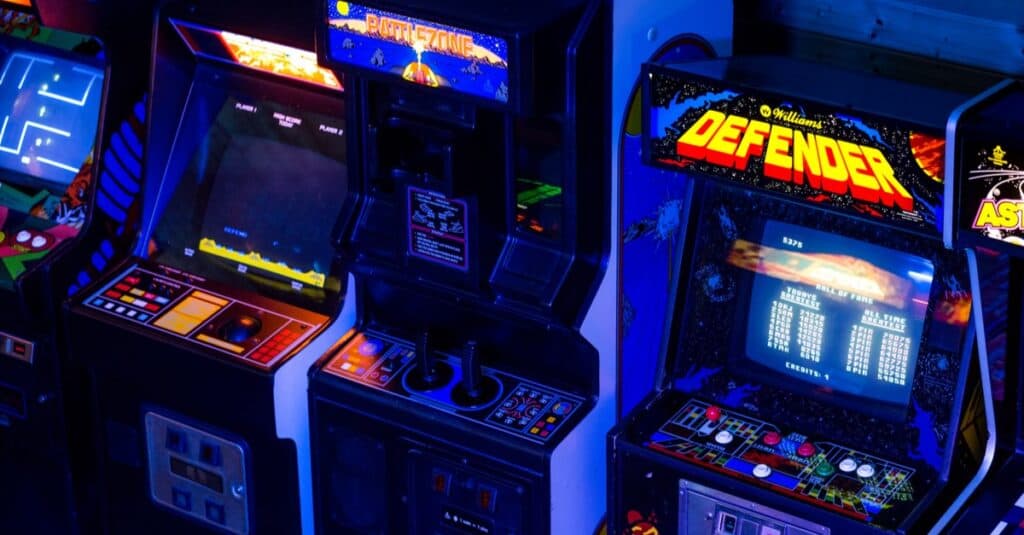
©Atmosphere1/Shutterstock.com
Video Game Arcade Cabinet
Atari, notably Ted Dabney and Steve Bushnell, created the video game arcade cabinet. This invention is what allowed the creation and advancement of all games.
Atari Video Computer System
After going corporate, Atari put its late 70s research into home gaming consoles to work. They began to launch video game systems and home computer systems that performed well until the mid-80s.
Atari ST
The Atari ST is a line of home computing systems from Atari Corp. This series had the first computer to come with a bitmapped color GUI. In 1986, the 1040ST became the first personal computer to ship with a megabyte of RAM.
Atari 2600
The original Atari VCS was eventually renamed the Atari 2600. This home gaming system allowed consumers to swap out cartridges to bring home games that were previously exclusive to the arcade.
Atari 5200
In 1982, Atari released the Atari 5200 SuperSystem. It was meant to be a higher-end model of the Atari 2600. However, due to the home computing revolution, Atari decided to repurpose the model as a home computing machine. This lead to the Atari 400 and 800.
Atari Lynx
The Atari Lynx was among the first batch of handheld gaming systems. It was a hybrid 8-bit and 16-bit handheld console released in September 1989. It was the world’s first handheld console with a color LCD. This device was in direct competition with Nintendo’s Game Boy, Game Gear, and TurboExpress.
Classic Video Games
- Pong
- Centipede
- Missile Command
- Tank
- Breakout
- Gotcha
- Space Race
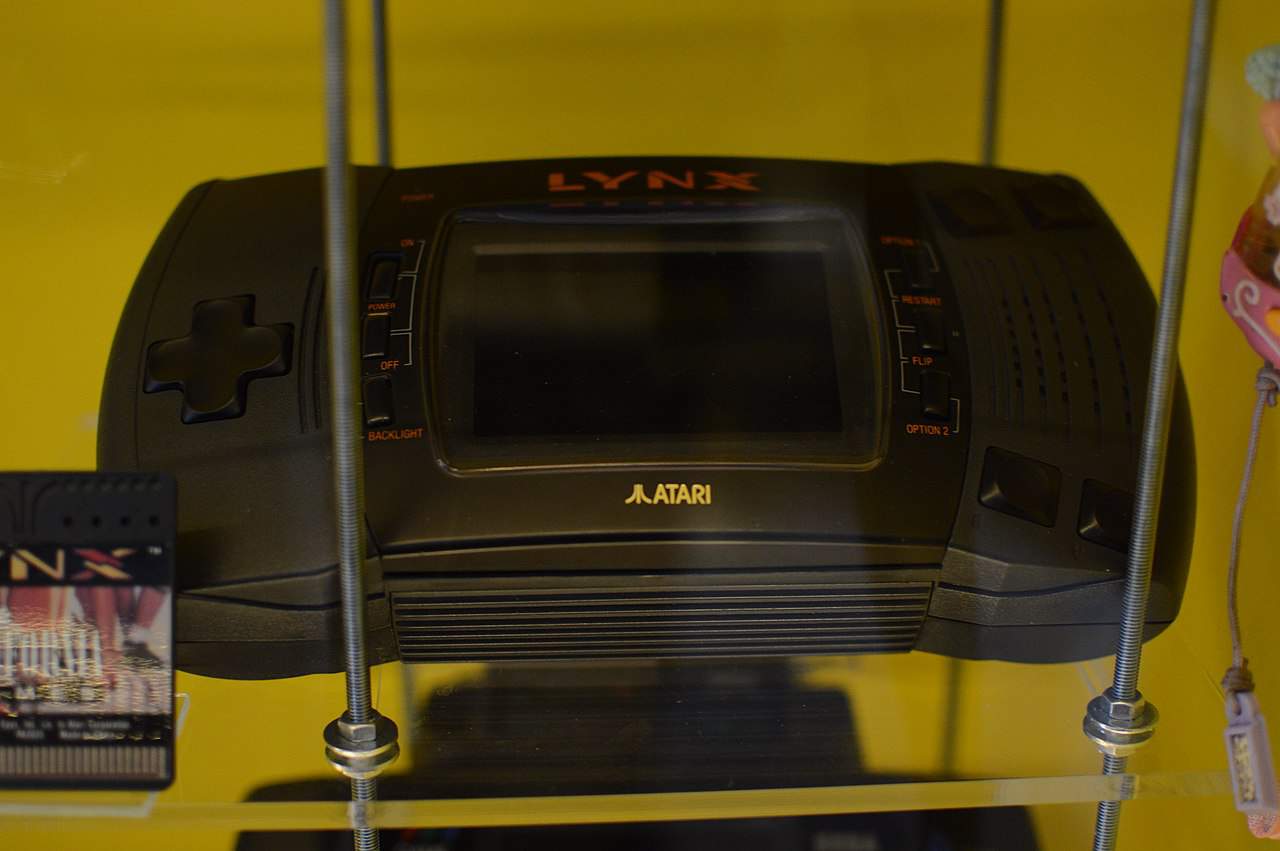
©Wojciech Pędzich, CC BY 4.0, via Wikimedia Commons – Original / License
How Does Atari Make Money?
Atari has made money in two fashions. They create and sell a product. They also manage software and licensing rights. Historically, they made money through coin-operated arcade machines. The modern Atari exists almost exclusively as a software license.
Atari: Notable Controversies
Magnavox: Table Tennis Patent
In 1974, Ralph Baer, inventor of the Odyssey, convinced his employer to initiate a lawsuit with Atari over plagiarism. He claimed that Atari copied the idea for Pong from Table Tennis which he claimed was original. He cited Bushnell’s attendance at a demonstration of the game in 1972. Games like Table Tennis and Pong had existed and been demonstrated since 1958. Atari had a strong argument to claim that Pong was original and not a copy of Table Tennis.
Bushnell decided not to fight the claim in court. Instead, he settled the issue for an amount between $400,000 and $1 million and became a licensee of Magnavox. Bushnell believed this was the best way forward. It meant that he would not have to continue to worry about copyright licensing and pursuing intellectual property theft. For Atari, this meant the company could focus on making new games and products.
Warner’s Fatal Decision
Warner did not know how to operate as a technology-driven entertainment company. They only sought to continually sell what they already had available. In the world of video games and technology in general, this is a self-imposed death sentence.
By not producing and continuing the advancement of their technology, they lost the money to continue operating. This is most notable by Warner’s decision not to release the handheld console, The Cosmos. The Cosmos was a handheld console that used holography to create 3D-styled images. It was what may be considered the earliest model of a Nintendo 3DS.
Even with more than 8,000 pre-orders for the device and years of development, Warner decided against releasing the product. It became more evident that Warner was unwilling to keep up in development in the mid-80s as former inferior competitors outperformed Atari’s computer offerings altogether.
What’s Atari Doing Now?
Today, Atari exists in name only. Hasbro Interactive purchased JTS for $5 million to obtain the rights to the Atari name. They have used it for branding opportunities with hotels and casinos. The name is the same, but the company is no more.
Next Up…
- Cash Register: The Complete History
- Code-Breaking (Cryptanalysis): A Complete History
- The Complete History of Tennis for Two
The image featured at the top of this post is ©Tinxi/Shutterstock.com.
